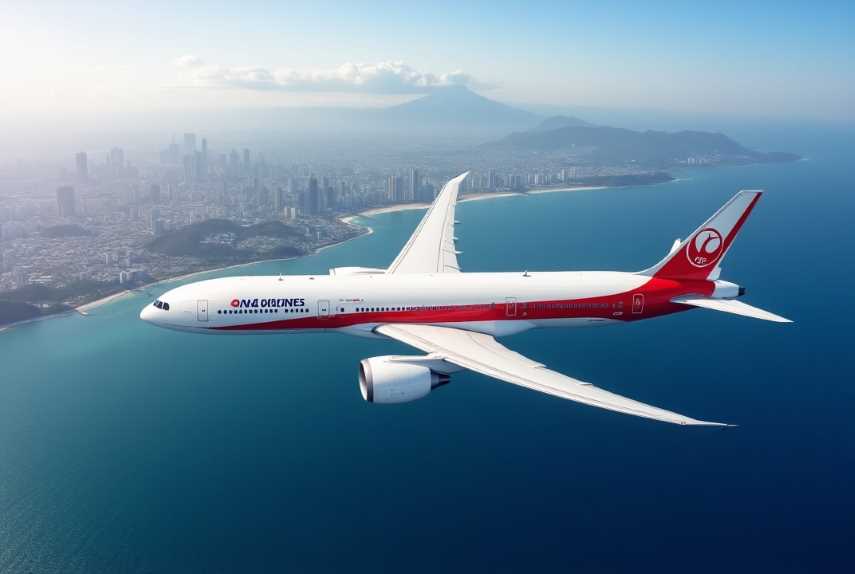Published on
September 21, 2025
All Nippon Airways (ANA) and Japan Airlines (JL) have just posted huge profit increases, thanks to booming business travel to and from Japan and the United States. The imposition of tariffs by President Trump in 2025 changed global trade as we know it and facilitated the need for in-person meetings among business executives. This has led to a huge increase in the demand for premium seats on nonstop transpacific flights, a boon for carriers such as ANA and Japan Airlines.
The number of outbound flights ex-Tokyo Narita International Airport (NRT) and Haneda Airport (HND) to major points in the United States, such as Chicago O’Hare International Airport (ORD) and Los Angeles International Airport (LAX), has grown tremendously. This increase has been attributed to business executives traveling on a more regular basis to clinch deals, monitor production relocations, and manage the consequences of the tariffs. Both ANA and Japan Airlines have noted a clear connection between the tariffs and the increase in demand from business passengers on transpacific flights.
Effect of Tariffs on Airline Profits
The expansion of the US tariffs as of 2025 has most certainly affected global supply chains, and tariffs on Indonesia now stand at 19%. In addition, the Japan-related chains in China and Vietnam have also experienced heightened costs. While the tariffs have indirectly boosted business travel, most of the negotiations of the manufacturers and executives have opted for in-person meetings to iron out production issues. The increased demand for business and first-class travel on ANA and Japan Airlines has, in part, been attributed to these factors.
Analysts point out that the US tariffs have now compelled companies to make operational changes to, among other things, recreate their supply chains. Thus, as business travel gained prominence, so too did the war for capture. ANA and Japan Airlines have equally increased their revenues from premium class bookings. The surge in executive travel in the North American and European markets is the reason for the strong performance of ANA in these markets.
Profit Growth for Japan Airlines and ANA
Business class travel growth proved beneficial for both Japan Airlines (JL) and ANA (NH), as uncovered during the latter’s quarterly earnings. Japan Airlines said its revenue in the Q1 FY2025 rose by 11% to 471 billion Yen (USD 3.18 billion), with a projected annual revenue of 1.93 trillion yen. Operating profit in Q1 is pegged at 170 billion yen, with travel being a key factor.
Japan Airlines has also stated that the transpacific demand has “picked up” as evidenced by growth in bookings of business and first class travel for June 2025 that is in the mid-teens. This also demonstrates the impact the U.S. tariff has on the airline’s profits. As more and more analysts examine the profitability of Japan Airlines, the results suggest that prospects for future quarters are brightening.
In contrast, as a result of the increasing passenger revenue of 5% in premium cabins, ANA also earned record profits in international profits in the same quarter. Additionally, the company reported that 62% of the operating income target was met in the first half of FY 2025. This was achieved even as there was a 7% decline in the demand for cargo, mostly caused by the transpacific trade slowdown. This was somewhat corrected by the increased volume of business travel, which, in turn, was a factor in the decline in cargo revenue.
Growth in Premium Travel and Long-term Prospects
Most, if not all, airlines remain positive in the long term as the U.S. business travel market is very strong. Japan Airlines’ and the ANA’s long-term focus on the transpacific and international route networks, respectively, provides a buffer against tariffs and the other headwinds the industry is facing. The rest of the industry is even more bullish, expecting the demand for business class travel to remain very strong through the end of 2025.
The data from JNTO suggests that the growth from this activity matches a larger trend of a 14% year-over-year increase in outbound travel. In 2025, the outbound market for premium business travel is estimated to be worth USD 8.514 billion, and the overall market is projected to reach USD 90.1 billion in 2035, reflecting a 26.6% CAGR. These figures illustrate the increasing importance of international travel, especially for corporate and business travel.
Strategic Airline Expansion Amidst the Shift of Trade
The U.S.-Japan trade framework introduced in July 2025 provided some cool relief to the automotive sector, but it caused a rise in costs for most airlines. Aluminum tariffs of 5-10% have increased aircraft fares a tad and created a bit of a pricing squeeze. Still, Japan Airlines and ANA have both been proactive in modifying route profitability and capacity for high-demand markets.
Japan Airlines has been busy expanding its route network and bolstering cross-border air services, and in August 2025, added the new service to San Francisco and added more flights to the Narita to Chicago O’Hare and the Narita to San Diego routes. ANA has also been active, particularly launching Air Japan to service the Asian market and pulling back some of its routes to Europe, which have been very soft and lacking demand.
Conclusion: Japan Airlines and ANA Show Profitability and Growth Despite Challenges
Both ANA and Japan Airlines have faced rollercoaster challenges with U.S. tariffs; however, ANA has experienced profits driven by business-class air travel. Profits indicate that the shifts within in-person negotiations and trade changes, as well as the elevated demand for international air travel, had a considerable influence on the demand for international air travel. Both Japan and ANA Airlines have extended bases, which translates to a positive outlook toward sustained growth with international business travel. These factors mean that both firms are well poised to continue to compete in the global market for as long as the forecasted growth through the rest of 2025 and well into the following periods comes to fruition.
